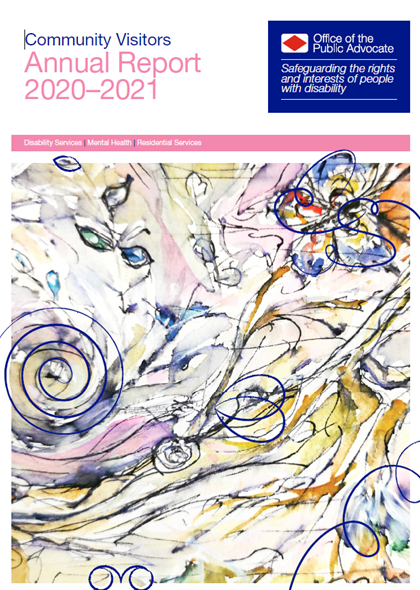The Prevention model of Community Visitors [excerpts from 2020-21 Victorian Community Visitor Annual Report]
Today’s post complements an article by Dr Rae West published on Power to Persuade earlier this week. It discusses the critical role of Community Visitors for people living in disability accommodation, who work to to improve the lives of residents and their home environment, their choices, and their opportunities. Community Visitor schemes operate across all States and Territories in Australia except Western Australia and Tasmania. This post is printed with the permission of the Office of the Public Advocate (OPA) Victoria. If you feel a person with disability is being denied their human rights in Victoria, please contact OPA at https://www.publicadvocate.vic.gov.au/ or (in Australia) on phone 1300 309 337.
Community Visitors have a critical safeguarding role people living in disability accommodation. They work to improve the lives of residents and their home environment, their choices, and their opportunities. Community Visitor schemes operate across all States and Territories in Australia (excluding Western Australia and Tasmania).
As an example, in Victoria, Community Visitors visited 1168 group homes during the 2020-21 reporting period. They undertook 2124 visits in person, when care directives allowed, as well as phone and video conference calls to meet with residents and staff.
Community Visitors are empowered by legislation to visit specified facilities, to make enquiries of residents and staff and examine selected documentation in relation to the care of people residing at the facilities. Community Visitors make both announced and unannounced visits in a team of two or more.
At the conclusion of each visit, the Community Visitors prepare a report summarising the findings and indicating items where action is required. A copy of the report is provided to the most senior staff member at the facility or the proprietor in the case of an SRS.
In this reporting year, 81 requests for Community Visitors were made by telephone or email to the Office of Public Advocate Advice Service in Victoria where the Victorian scheme is based. Depending on the nature and urgency of the request they were treated as either a special visit or absorbed into the regular visiting cycle. The requests can come from residents themselves, concerned family, friends and community members, staff directly supporting the resident or service providers and from anonymous callers.
Residents in group home settings remain at higher risk of violence and abuse. Community Visitors seek to identify issues before they escalate to prevent serious violence, abuse and breaches of human rights occurring. Any serious issues are referred to the Office of the Disability Services Commission or the NDIS Quality and Safeguards Commission for investigation and action.
Remote safeguarding since Covid-19 has had its unique challenges. One of the most significant of these has been the difficulty Community Visitors had in accessing client documentation in the homes the residents they visit, an important part of their oversight role particularly for people with complex needs. They were able to continue to report on serious concerns about inadequate care and support as well as provide feedback on areas of good practice with service delivery.
Community Visitors have continued to be human rights warriors for the many vulnerable people they visit. In these truly unprecedented times, they have diligently and selflessly continued to provide support and encouragement to many isolated and at risk members of our community with disability.
CASE STUDY
Juliette and Trevor moved into the same home in 2017 and Community Visitors have documented long-standing and escalating issues of incompatibility. Verbal abuse was normal and constant, lasting for several hours. Staff found it difficult to maintain physical distance between residents as assaults from one to the other were mostly unprovoked.
Despite modifications to the house to keep them physically separated, medical assessments and behaviour support strategies, the situation deteriorated. This impacted on both residents’ mental health.
Four notifications were made to the DSC and two referrals to the NDIS Quality and Safeguards Commission.
In April 2021, Trevor moved into temporary accommodation in an empty house. Both residents were well supported and happier living by themselves and they continue to be monitored for their physical and mental health needs.
Community Visitors were pleased a temporary solution was found but were concerned it took over four years to occur.
The 2020-21 Victorian Community Visitor Annual Report in full can be found at https://www.publicadvocate.vic.gov.au/opa-s-work/our-organisation/annual-reports/community-visitor-annual-reports/363-community-visitor-annual-report-2020-2021
Content moderator: Rae West

